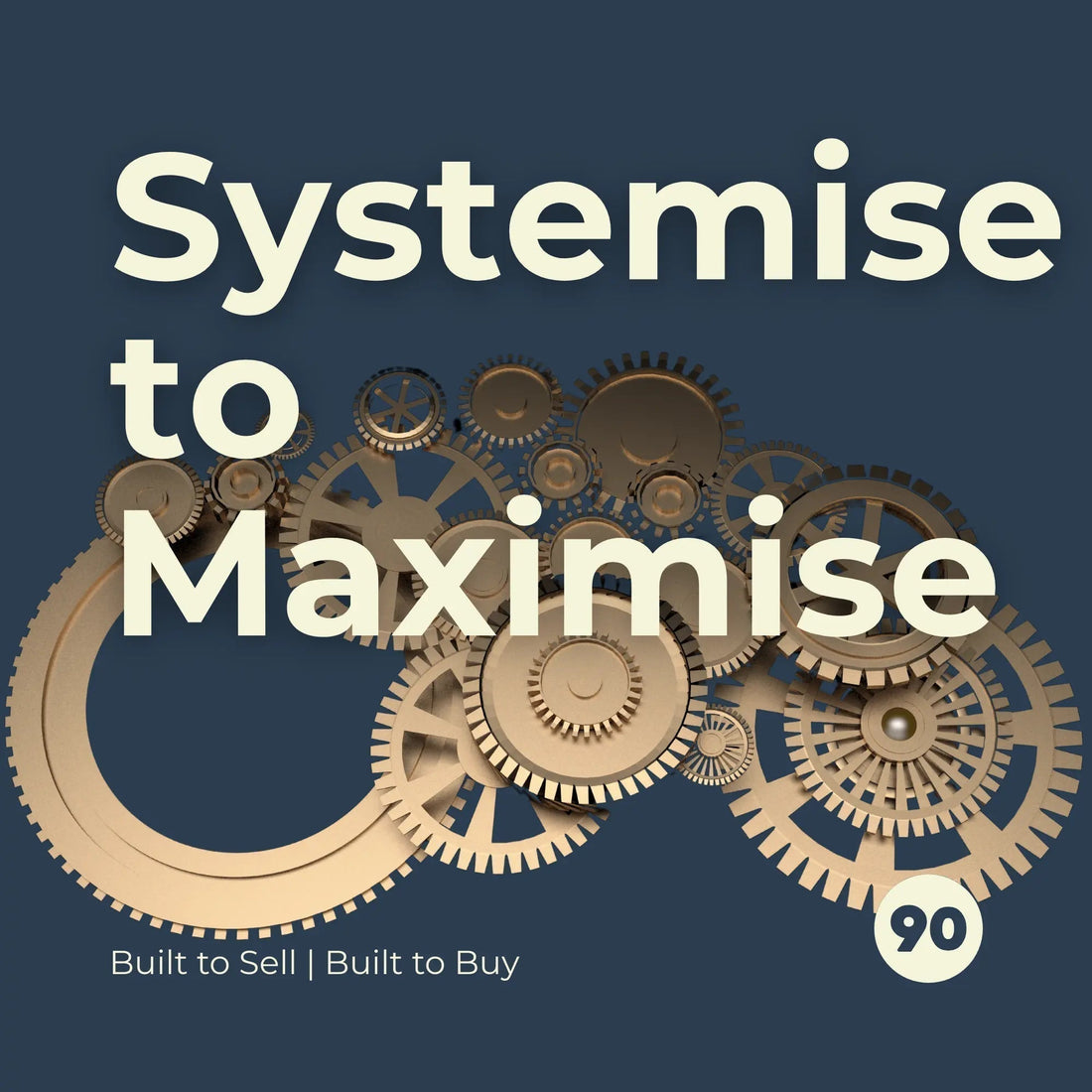
Systemise Your Business: Steps to Build a Business That Runs Without You
Share
Most business owners start their journey as problem-solvers. You identify an opportunity, hustle hard, wear every hat, and build something of real value. But somewhere along the way, that same energy that built the business becomes its biggest constraint. You’re indispensable. Every major decision, every client issue, every operational hiccup somehow ends up on your plate. This is why you need to systemise your business. Systemise to Maximise.
Listen to the Podcast Episode:
This guide, the steps to systemise your business, is for founders who want to break free from that cycle. Whether you’re planning to sell, scale, or simply create a business that doesn’t own you, this document will show you how to systemise what you’ve built - not just to survive, but to maximise.
Why Systemisation is Non-Negotiable: Systemise Your Business
Every business, no matter how successful, eventually reaches a tipping point. You can either keep running on founder grit, or you can build something that runs on process. The latter is where real value lives.
Let’s be clear: chaos is expensive. It drains your margins, stalls your momentum, and burns you out. When your team relies on memory instead of process, when every decision is ad hoc, when mistakes keep repeating - you’re paying a tax on disorganisation every single day. And it compounds.
Worse still, chaos is a red flag to investors and buyers. While you might see your hard work as the glue holding everything together, a buyer sees it as a risk. If the business falls apart when you step away, they’re not buying a company - they’re buying a job.
Systemisation changes that. It transforms your company from founder-centric to process-driven. From reactive to strategic. From fragile to scalable. Now is the time to systemise.
The Three-Phase Path to Systemising Business
Systemising a business doesn’t happen overnight, and it doesn’t need to feel overwhelming. I break it down into three core phases: Document, Delegate, Automate. Each one builds on the last. These are the three steps to systemise your business. By systemising business, you will remove red flags during due diligence & instil confidence in business buyers.
Phase 1: Document - Create the Playbook
Before you can scale yourself out, you need clarity. Most businesses operate on tribal knowledge - the undocumented know-how that lives in the founder’s head or scattered across emails and Slack threads. That’s not sustainable.
Start by identifying the core functions that drive your business - sales, fulfilment, admin, customer experience. Then map them out. Not in theory, but in detail.
Write down the steps. Record videos walking through tasks. Create templates. Keep it simple but thorough. These are your Standard Operating Procedures (SOPs), and they form the foundation of a scalable operation.
This isn’t about bureaucracy. It’s about removing friction. When your team has a clear path to follow, you unlock consistency, quality, and speed - without needing to hold their hand.
Phase 2: Delegate - Build a Self-Managing Team
Once your processes are documented, you can start transferring ownership. But effective delegation is more than handing off a task - it’s about creating autonomy without creating risk.
Start with low-value tasks you’re still doing. Use the DTT-R model: Define it clearly. Train the person. Trust them to deliver. Review the outcome and refine. This loop creates not just execution but growth.
Don’t just give someone a to-do list. Give them clarity on expectations, metrics, and the purpose behind their work. Empower them to solve problems, not just complete tasks. This is how you turn team members into leaders.
With delegation done right, your business doesn’t just run - it grows without you in the way.
Phase 3: Automate - Leverage Tools That Scale You
Once processes are clear and repeatable, it’s time to let tech do the heavy lifting. Automation isn’t about removing humans - it’s about eliminating unnecessary effort. It frees up your team to focus on high-value work.
Look at where you’re repeating the same steps over and over. Lead follow-ups. Invoicing. Reporting. These are prime candidates for automation.
Use tools like Zapier or Make to connect systems. Implement project management tools like Asana or ClickUp to streamline workflows. Use CRMs like HubSpot to track and convert leads without chaos.
But remember: never automate disorganisation. If your process isn’t working, automating it will just multiply the mess.
Why Most Owners Fail to Systemise (and How You Won’t)
Perfectionism kills momentum. Most founders hold off on systemising because they think:
- “It’s not the right time.”
- “We’re too small.”
- “I’ll do it once things calm down.”
- “I need to find the perfect tool first.”
Here’s the truth: You don’t need perfect systems to start. You need working ones. Version 1 is always rough. But it’s also the only path to version 10.
Start documenting messy. Start delegating small. Start automating light. Build from there.
The Real Goal: From Operator to Architect
You didn’t start your business to become its most overworked employee. Yet that’s where most founders end up. Stuck in operations. Chained to urgency. Struggling to scale.
The real shift - the one that changes everything - is when you stop operating the machine and start designing it.
You focus on strategy instead of tasks. On vision instead of firefighting. On growing value instead of putting out fires. That’s when your business becomes not just a job, but a real asset.
A Tale of Two Founders
Let me paint you a picture.
Founder A built a $1M/year business. She works 70-hour weeks. Knows everything. Does everything. She’s proud of her team, but if she’s gone for a week, the wheels start wobbling. When it’s time to sell, the best offer she gets is 2x earnings. Why? Because she’s the business.
Founder B built the same size company. But she invested in documentation. Built systems. Trained her team to take the lead. She works 3 days a week. Has time for family, strategy, and growth. When she’s ready to sell, she gets 3.5x earnings. Same profit, very different value.
That’s the ROI of systemisation.
Start Now: A Practical Jumpstart
If you’re ready to start, don’t overthink it. Here’s what I recommend:
- Write down 10 tasks you do repeatedly each week.
- Choose one. Record yourself doing it.
- Write down the steps. That’s your first SOP.
- Give it to a team member. Show them the video. Talk them through it.
- Set a follow-up for 1 week later. Review, refine, repeat.
Do this once a week, and in 90 days, you will be stunned at how much you’ve replaced with process.
Let’s Build It Together
If you want help making this real, that’s exactly what I do. My 90-Day Execution Accelerator is built for founders who are serious about building systems, freeing up time, and growing valuation.
Together, we’ll:
- Audit where your chaos lives
- Prioritise the systems that create leverage
- Build playbooks and install delegation loops
- Layer in automation that scales
- Hold you accountable every step of the way
You’ll walk out with a business that’s not just better to run - but far more valuable.
Book a free discovery call and let’s map it out.
